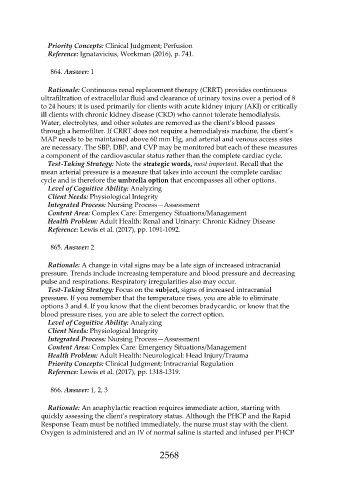Page 2568 - Saunders Comprehensive Review For NCLEX-RN
P. 2568
Priority Concepts: Clinical Judgment; Perfusion
Reference: Ignatavicius, Workman (2016), p. 741.
864. Answer: 1
Rationale: Continuous renal replacement therapy (CRRT) provides continuous
ultrafiltration of extracellular fluid and clearance of urinary toxins over a period of 8
to 24 hours; it is used primarily for clients with acute kidney injury (AKI) or critically
ill clients with chronic kidney disease (CKD) who cannot tolerate hemodialysis.
Water, electrolytes, and other solutes are removed as the client’s blood passes
through a hemofilter. If CRRT does not require a hemodialysis machine, the client’s
MAP needs to be maintained above 60 mm Hg, and arterial and venous access sites
are necessary. The SBP, DBP, and CVP may be monitored but each of these measures
a component of the cardiovascular status rather than the complete cardiac cycle.
Test-Taking Strategy: Note the strategic words, most important. Recall that the
mean arterial pressure is a measure that takes into account the complete cardiac
cycle and is therefore the umbrella option that encompasses all other options.
Level of Cognitive Ability: Analyzing
Client Needs: Physiological Integrity
Integrated Process: Nursing Process—Assessment
Content Area: Complex Care: Emergency Situations/Management
Health Problem: Adult Health: Renal and Urinary: Chronic Kidney Disease
Reference: Lewis et al. (2017), pp. 1091-1092.
865. Answer: 2
Rationale: A change in vital signs may be a late sign of increased intracranial
pressure. Trends include increasing temperature and blood pressure and decreasing
pulse and respirations. Respiratory irregularities also may occur.
Test-Taking Strategy: Focus on the subject, signs of increased intracranial
pressure. If you remember that the temperature rises, you are able to eliminate
options 3 and 4. If you know that the client becomes bradycardic, or know that the
blood pressure rises, you are able to select the correct option.
Level of Cognitive Ability: Analyzing
Client Needs: Physiological Integrity
Integrated Process: Nursing Process—Assessment
Content Area: Complex Care: Emergency Situations/Management
Health Problem: Adult Health: Neurological: Head Injury/Trauma
Priority Concepts: Clinical Judgment; Intracranial Regulation
Reference: Lewis et al. (2017), pp. 1318-1319.
866. Answer: 1, 2, 3
Rationale: An anaphylactic reaction requires immediate action, starting with
quickly assessing the client’s respiratory status. Although the PHCP and the Rapid
Response Team must be notified immediately, the nurse must stay with the client.
Oxygen is administered and an IV of normal saline is started and infused per PHCP
2568

